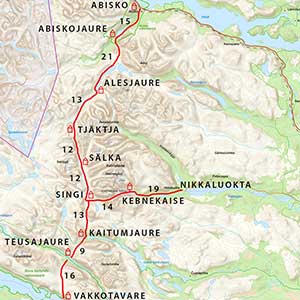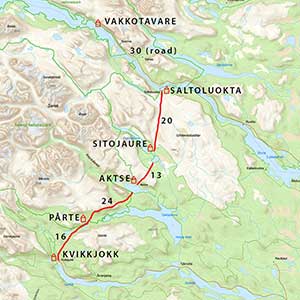12 Days
273 km
difficult/Moderate
5665 m
5665 m

Kungsleden – King´s Trail
A 12 day tour through the imposing highlands of Sweden, north of the Arctic Circle. A hike through the Abisko National Park and past the Sarek National Park.
Explore the Kungsleden in our video!
Are you looking for our detailed hiking report, stages or maps?
Kungsleden, Sweden – Our Hiking Experience
| The path is adequately marked in most of the sections. Red horizontal stripes are painted on stones or trees. Wooden signs can also often be found. Sometimes a simple map is useful. Don’t spend money on expensive cards. | |
| The website www.resrobot.se offers good planning services, while train tickets can be conveniently booked online at www.sj.se. Bus connections via www.lapplandspilen.se, timetables at www.ltr.se. You need time to travel in Sweden as there are often only a few transport connections per day. We started in the north, so we flew to Kiruna and then you can take the bus or taxi to Abisko. | |
| The biggest challenge is the changeable weather. All in all, perseverance is the key to this tour. There are a few climbs to be mastered. If you want to hike to whole trail northern & southern part, then prepare yourself four 800km. | |
| Cash is not always accepted. You need a credit card, e.g. for bus connections. Sweden is known for paying for many things with cards. | |
| There are no catering options on many sections. Therefore, you have to take care of yourself for the most part. The food supply in the mountain stations is extensive, but a little more expensive. | |
| There are accommodations, the so-called mountain stations, along the entire route. There you can get something to eat and spend the night there. But the best thing in Sweden is the “everyone’s right”. That means you can pitch your tent anywhere, at least for one night. Maybe not right next to the hut. However, the prices for accommodation and meals are expensive. Most of the relevant Kungsleden huts are operated by the STF, so membership in Svenska Turist Föreningen is recommended. The annual family / couple fee is 450 SEK and includes discounts on accommodation and boat transfers. | |
| The landscape is simply breathtaking. With a bit of luck you will also see herds of reindeer. Moose can also be seen but are rare. A tour without distraction! | |
| Sometimes you walk on narrow wooden boards that lead over particularly muddy places or over impassable terrain. Depending on the winter situation, even in midsummer, some sections can be covered by snow. Hiking sticks are highly recommended. Mosquitoes can become a nightmare in the summer. We only saw this in certain areas like Aktse or the forest around Kvikkjokk. |
Stages we hiked
1. Abisko to Abiskojaure, 13 km
2. Abiskojaure to Alesjaure, 22 km
3. Alesjaure to Sälka, 23 km
4. Sälka to Teusajaure, 29 km
5. Teusajaure to Saltoluokta, 14 km
6. Saltoluokta to Skierffe (1179m), 36 km
7. Skierffe to Fjällstation Jägge, 20 km
8. Jäggehütte to Kvikkjokk, 26 km
9. Kvikkjokk to Tsielekjakk hut, 15 km11. Tjäurakatan to Hostel Vuonatjviken, 22 km
12. Vuonatjviken to Jakkvikk, 23 km
12. Vuonatjviken to Jakkvikk, 23 km

Overview of the northern Kungsleden in 3 sections



Kungsleden is the famous long-distance trail in the north of Sweden and divided into two routes: the northern and the southern Kungsleden. He is also called the King’s Trail. The northern section leads about 440 kilometers from Abisko to Hemavan, while the southern section takes you to Storlien, about 350 kilometers from Sälen. We hiked the first 300km on the northern Kungsleden from Abisko to Jäckvik. The trail will also take you around Sweden’s highest mountain, the Kebnekaise (2099m).
endless summer light
Since the Kungsleden is beyond the arctic circle in the north of Sweden, you should take advantage of the summer months for hiking. On the one hand it gets very cold here in winter and on the other hand it gets dark very early. The special feature of the summer, however, is that it is still bright at night – in July, for example, you have 24 hours of daylight – so you do not have to worry about setting up your tent in time for nightfall. The only drawback in the summer are the many mosquitoes in certain areas that can really annoy you on windless days.
For more information about the hiking trip Kungsleden don´t hesitate to contact us. Feel free to watch our videos on YouTube and explore our other trails we´ve experienced for you!
Take care and go out and make it happen!



